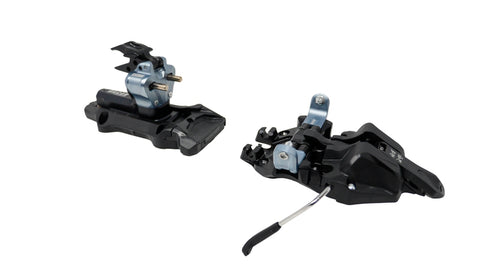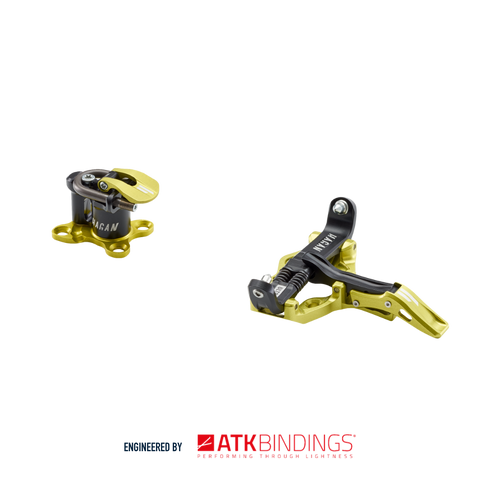The HAGAN Binding Lineup Explained
by Simon Zink May 07, 2024 7 min read
If you are unsure of the differences between our eight bindings, and which one is the best for you, here's a little help.
The Fundamentals
- Pure 8 and Pure 10 - lightest and cheapest (identical to ATK Crest 8/10)
- Pin Up 8 and Pin Up 10 EVO - automatic brake system is easier and you can't forget to release them for the descent (identical to ATK RT8/10 EVO).
- Core 12 EVO - higher release range and fancier toes than the Pin Ups (identical to ATK Raider 12 AP).
- Core FR 15 EVO - new freeride binding for 2024 with ATK proprietary toe and heel release tech for a more precise release, included freeride spacer and the highest release value in the lineup
- Boost 12 - easiest operation of all and brakes always release, even while climbing and in transitions (identical to ATK Front 12).
- Ultra World Cup - specialty super light race and light touring binding (identical to ATK Sl World Cup)
- Ultra World Cup Brake - specialty super light race binding with a brake. ISMF compliant with the new brake requirement standards implemented in 2020/2021, and which will be enforced by USA Skimo starting in 2024/2025 (identical to ATK Sl World Cup Brake)
The Details
CORE FR 15 EVO:
The FR 15 stands alone in the freeride pin binding industry, with an adjustable release toe piece. Adjustable release values have been around forever on pin bindings, however until now, adjustment has only taken place within the heel piece.

Historically, toe pieces have been set at a fixed median release value, causing the binding to balance the load force unevenly. Subsequently, when the binding release is set lower than the median value of the range, which lowers the release in the rear, the toe piece spring is primarily responsible for managing the forces and security of the boot. When the release is set higher than the median value of the range, the opposite occurs, and the rear supports most of the load. This means the binding is vulnerable to variable loading between the toe and rear, and the boot can release when experiencing a force at or above the median value of the release range, despite the binding being set to release at a higher DIN than the median. The FR 15 allows the binding to balance the load evenly, putting less strain on a single part of the binding, and ultimately creating a binding with a truly precise release.
Boost 12 versus the Core 12 EVO:
At 360 and 380 grams respectively, the Core 12 EVO and Boost 12 are similar free-touring centric bindings. Both have identical release ranges of 5-12 and a heel/toe drop of 12 mm. These touring bindings are designed to maximize downhill performance, while minimizing weight as much as possible without compromising this downhill oriented function.
The most significant and obvious difference between the Boost 12 and the Core 12 EVO is the brake mounting position. The Core 12 EVO has typical heel mounted brakes, while the brakes for the Boost 12 are equipped at the toe. So, what are the possible advantages of toe-mounted brakes of the Hagan Boost 12 brake system?
 |
 |
| Boost 12 | Core 12 EVO |
- The HAGAN Boost 12 brakes are always active (in both descend AND climb modes.) Always Active means if the toe of your boot isn't in the toe piece, the brake WILL be deployed. They can't be locked away if the boot isn't in the toe piece. This means you also can't FORGET to release your brake - and realize it when you see your ski heading down a couloir. Core 12 EVO brakes are also automatic but only when in descend mode. Engaging the heel into the binding releases the brake, making it ready to deploy if the ski were to disengage from the boot.
- The brake retraction is done with the same lever, and same motion, as locking the toe for uphill climbing mode. It saves steps, and time, over separately retracting the brake at the heel, then locking the toe piece. The locking and retracting motion is smooth and easy.
- Toe-mounted brakes don’t interfere with heel release. No worries about friction with the brake pad interfering with smooth and reliable heel release. (The front brakes don't interfere with toe release, either, for that matter.)
- The Boost 12 bindings are light, because the heel tower doesn't have to beefed up to perform the additional duty of holding the brakes in a retracted position - with an awkward twisting to hold down the brake. The brakes also don’t need to be beefed up to withstand repetitive “stomping” during heel click in.
In Summary:
The Boost 12 bindings are about 10 grams heavier than the Core 12 EVO. But the convenience of retracting the brakes with a single pull of the toe lever, combined with eliminating the possibility of a ski taking off while climbing or transitioning, may be worth it depending on your use. If you are consistently traveling in terrain where a ski falling off would be detrimental to your tour, such as up couloirs or steep backcountry peaks, I'd recommend going with the Boost 12 purely for the insurance of knowing your brake is always activated and ready to deploy if you were to slip on the skin track and your ski were to fall off. If this is less of a worry for you, and you are more concerned about brake functionality for the descent, then take the 10 grams in weight savings and EVO automatic brakes of the Core 12 EVO.
EVO How the EVO Automatic Brakes work:
There are also differences in the Boost 12 and Core 12 EVO toe pieces – other than the brakes, obviously. Most of those differences are the same as those between the Pure 8/10 and the Core 12 EVO toes.
Core 12 EVO versus the Pure 8 and Pure 10:
 |
 |
| Core 12 EVO |
Pure 8/10
|
The Pure 8/10 is a user friendly, reliable, and lightweight touring binding. Here's how it stacks up against the Core 12 EVO:
Heel:
- Brakes: The Pure 10 brakes retract with a simple push pin system. The Core 12 EVO bindings have the even simpler automatic brakes that release automatically in descent mode.
- There are two risers on the Core 12 EVO and Boost 12 versus one riser on the Pure 10.
- The Pure 10 has three climbing heights - the middle height is engaged by just flipping the heel flap forward. The flat and high heights are reached by twisting the heel piece.
- The Core 12 EVO/Boost 12 dual risers are magnetic – a little easier to flip – and enable flat, middle and high climbing positions without twisting the heel back and forth.
- The Core 12 EVO/Boost 12 length adjustment is 25mm versus 20mm with the Pure 8/10.
- The Core 12 Pro/Boost 12 have a higher Z-value (DIN) range of 5-12 versus the 5-10 of the Pure 10.
- Freeride spacers are only compatible with the Core 12 EVO, Pin Up 8/10 and Boost 12 and increase downhill performance to near alpine binding levels, at a fraction of the weight of hybrid bindings like the Shift.
- All have the Elastic Response System.
If you think you may want to set the release below a DIN 5, then consider the Pure 8. The Pure 8 is identical to the Pure 10 but with a 3-8 DIN range.
Toe:
- The Core 12 EVO toe piece has a wider mounting plate, snow-block anti-icing system, easy entry toe guides and uphill retention adjustment.
- The Pure 8/10 is about 90 grams lighter than the Core 12 EVO.
Choosing between these two bindings depends on if the Core 12 EVO's automatic brakes, extra climbing heights, increased adjustment range and toe features are worth the extra weight for you. Personally, I prefer the Pure 8/10 despite those features of the Core 12 EVO due to the grams saving. If you aren’t as concerned about weight, and think the extra features would be useful to you, then take the Core 12 EVO.
Pin Up 8 EVO and Pin Up 10 EVO:
 |
 |
|
Pin Up 8 EVO
|
Pin Up 10 EVO
|
The Pin Up 8/10 EVO fit nicely between the Pure 10 and Core 12 EVO to fill out our lineup. This all around binding is equipped with EVO automatic brakes, unlike the Pure 10, while functioning as a slightly slimmed down version of the feature packed Core 12 EVO:
- The Pin Up EVO binding heels are identical to the Core 12 EVO heels, except with lower release settings. They have the same automatic brakes and dual Magneto heel risers. The heels are a big upgrade to the Pure binding heel units.
- The Pin Up EVO toes are identical to the Pure binding toes. They do not have the wider mounting points, adjustable climbing tension, easy in toe stops and springless design of the Core 12 EVO toes.
- Weight and Price - both slot in neatly between the Pure and Core 12 EVO bindings.
- Note the Pin Up 8 EVO is identical to the Pin Up 10 EVO other than its slightly lower adjustable release DIN range of 3-8.
Ultra World Cup vs Ultra World Cup Brake:
In the beginning of the 2020/2021 season, the IMSF introduced new brake ski brake requirements, making them mandatory in any race. The Hagan Ultra World Cup Brake Binding is identical to the ATK SL World Cup Binding. The Race Brake System developed by ATK is unique in its kind. When the heel flap is switched from uphill to downhill mode, the brake activates (releases) automatically. Similarly, when the skier wants to go back to uphill mode and switches the heel flap position, the brake locks (in its clearance position) without requiring any other movement.
The Ultra World Cup is identical to the Ultra World Cup Brake sans the brake. It is the perfect binding for lightweight ski touring, non sanctioned races, and peak/couloir hunting.

|
 |
| Ultra World Cup | Ultra World Cup Brake |
Summary
I don’t think one binding is necessarily better than the other. It depends on your usage, priorities and budget.
- If you want the lightest weight and lowest price, the Pure 10 is fantastic.
- If you want the automatic brakes, get the Pin Up 10.
- If you want automatic brakes, the wider toe mounts and higher release settings, the Core 12 EVO is great.
- If you want the simplicity of single lever activation and always active brakes so you don't need to worry about losing a ski - ever - get the Boost 12.
- If you plan on competing in USA Skimo or ISMF sanctioned races, then the Ultra World Cup Brake Binding is for you.
- If you want an ultra light binding for non sanctioned races or simply to minimize weight on your mountain, volcano, couloir, or groomer missions, then choose the Ultra World Cup Binding.
We appreciate your supporting Hagan and pledge to provide exceptional service and customer care.
Leave a comment
Comments will be approved before showing up.
